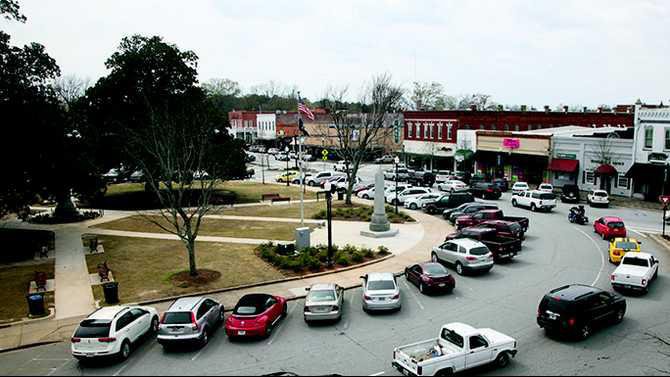Complaints have been heard about the parking — or lack of parking — available on the Square in downtown Covington.
The recent additions of Your Pie and Sweet River on Washington Street have brought more consumers downtown. With that comes both new tax revenue and new vehicular congestion.
“We have had exponential growth in our downtown area,” said Ralph Staffins, President of the Newton-Covington Chamber of Commerce. “This growth is something we need to be proud of. With growth comes new challenges. We look forward to working with the city of Covington to meet these opportunities head on.
“Discussing parking around the Square is a positive thing in our eyes,” agreed Trey Sanders, Public Relations Manager for the city. “It means the square is vibrant and people are shopping and eating in the heart of Covington.
“There is a perception that parking is an issue around the Square and it really isn’t,” he said. “People want to park directly in front of the store they want shop in or the restaurant they want to eat at. If they are willing to walk a block or less, they can typically find a parking place with ease.”
But others disagree. Council members Chris Smith, Post 1 East, and Hawnethia Williams, Post 2 West, reported at a council meeting last month that merchants on the Square had serious concerns about the lack of parking.
The concerns are not new, and last year, the Covington Parking Authority commissioned Kimley Horn to study and make recommendations about improving parking on or around the Square. The study was submitted to the city council in September last year. (See story, “What to do with downtown parking,” at http://www.covnews.com/archives/60565/.)
“They [Kimley Horn] detailed our current parking condition and gave us ideas for future improvement, if needed,” Sanders said.
He added that Mayor Ronnie Johnston, City Manager Leigh Anne Knight and Planning and Zoning Director Randy Vinson will revisit the study and talk to the consultants. They are planning to hold a town hall meeting to discuss options moving forward, he said.
“We hope to have that meeting sometime in April,” Sanders said.
The study showed that, while parking on the Square, and in the public lot north of the Square, during the peak hours of 10 a.m. to 6 p.m. may be difficult, there are underutilized parking areas nearby, including 319 parking spots on the street within two blocks of the Square and 142 spaces in the First Baptist Church parking deck.
“There are plans to create golf cart parking in spaces where cars can’t fit,” Sanders said.
Kimley Horn’s recommendations included installing directional signs directing people to nearby public parking, establishing parking time limits on the Square and on adjacent streets, adopting fee-based parking around the Square and, if needed, building additional parking southwest of the Square.
The changes would be broken up into four phases. The first phase was to install signs for pedestrian and vehicle traffic directing people to facilities and public parking. Capital costs were estimated at $29,500.
Sanders said, it is too early to tell how successful they have been. However, he said, comments about the signs has been favorable.
“The new signs are part of the education about other public parking close by,” Staffins said. “I think this education is part of the solution to letting people know there’s parking close by the Square.”
Phase two would be to establish parking time limits in and around the Square. It is estimated to run $25,000 in capital costs with annual operating costs of $73,000 for two enforcement personnel.
In the draft of the parking study, Kimley Horn said, “The existing parking operations include free on-street, off-street public, and off-street private facilities without time limits or enforcement. The greatest parking occupancy exists around the square where boutique retail promotes quick turnover, while restaurants require more spaces for longer periods of time. In some cases, employees are parking in prime parking spaces around the Square, leaving less available spaces for visitors and patrons.”
The report further states that if parking occupancies remain at 65 percent or higher after time-limited parking is instituted, the parking authority should consider adopting phase three and four.
Phase three would be to start charging for parking on the Square while retaining time limited parking within one block of the square. The cost of this phase is estimated to be between $96,000 and $190,000 in capital costs.
As existing and future developments come into the historic downtown area, the final phase would be to build parking southwest of the square, which could run between $800,000 and $4 million in capital costs. Annual operating costs would be an additional 20 percent of the construction costs.





